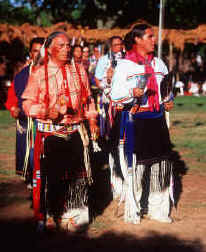Learning among Traditional Native Americans (TNA)...
CHARACTERISTICS

Learning among Traditional Native Americans (TNA)... CHARACTERISTICS |
 |
![]()
Forward | Objectives |
Introduction |
Assessing Needs | Characteristics of TNA Students |
Learning Concepts | Instructional Strategies
| Sample
Lesson Plan
|
WHO IS THE TRADITIONAL NATIVE AMERICAN (TNA) STUDENT ? It would be foolish, and insensitive, and shortsighted to characterize individuals through general group definitions. The following discussion is not intended to limit your interpretation of what your students are like. Rather, it is intended to serve as a door into greater understanding and further discussion. To the extent that they are helpful, the following comments are suggested here as a background for later discussion on teaching approaches and lesson plans, following this section. The following list is taken from http://www.literacynet.org/lp/namericans/understanding.html The article begins by giving examples of TNA who are different from each other, depending on their relationship to their own and their new culture.
[The traditional Native American student...]
Other characteristics/definitions are discussed at http://www.literacynet.org/lp/namericans/attitudes.html. Following is the introductory paragraph from that page to entice you to visit the site.
Dr. Bob Rhodes comments that most Native American students are not traditional, even those living on the reservations. They don't have all the characteristics mentioned above. They fall in between cultures--some tradition, some acculturation. They do not have much self identity. They see themselves as "Indians" or as members of a tribe, but they don't quite know what that entails. DISCUSSION WHEEL
APPLICATION 3
Click to continue |